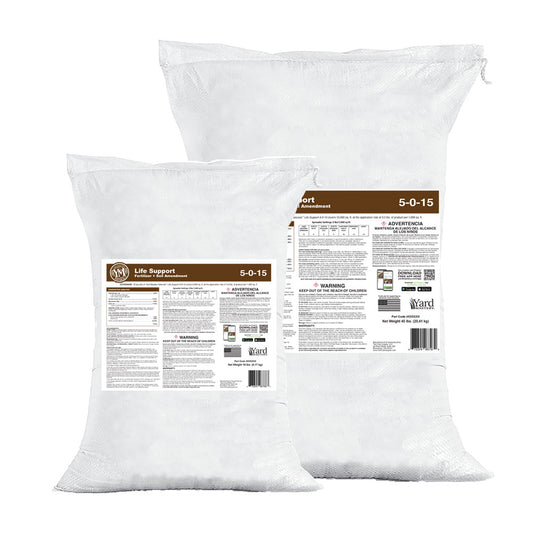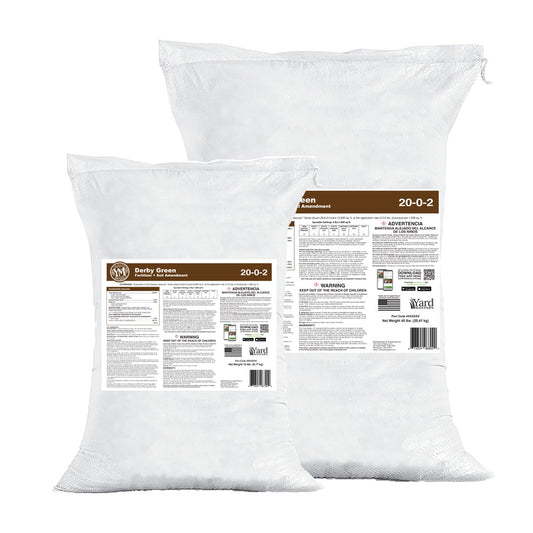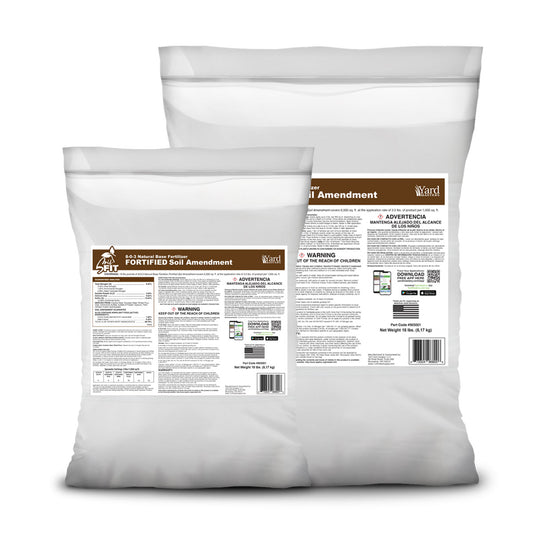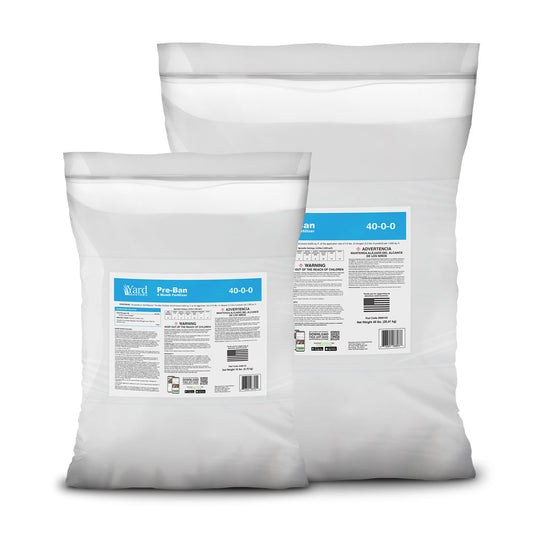The Guide To Humic Acid for Lawns
What is Humic Acid?
Spend any time searching for information on how to improve your lawn’s soil these days and for sure you will come across recommendations for Humic acid and fulvic acid treatments. The old farmers secret to improving soil structure is now mainstream and available in many online stores (including ours of course!) in both granular and liquid forms in small enough doses for us DIYers to utilize effectively without breaking the bank.
I talk to a lot of sod growers here in Florida and they just laugh when I talk about the great results I’ve been getting since adding humic acid treatments to my overall lawn treatment strategy.
Adding Acid to Soil?
People get a little scared when they think about adding an “acid” to their lawn. They wonder if it’s going to burn something, but I promise you, humic acid isn’t going to harm your lawn or soil, and in fact, is the secret to getting better results, faster from pretty much every other lawn application you do.
As far as the “acid” concern, think of humic acid more along the lines of orange juice (also acidic) for your soil. Everyone knows that OJ is good for you: it’s liquid sunshine and full of vitamins!
Humic acid is essentially the final remains of organic matter, primarily plant material, that has decayed over time and broken down into its simplest form by microbes. If you think poop is organic, natural, and good for plants, then think of humic acid as microbe poop. Super small, super rich, and super for your soil. (but no foul smell).
But what really sets humic acid apart from the average lawn amendment is its organic origin and how it supports a truly sustainable approach to lawn care. Unlike synthetic fertilizers, which can sometimes throw soil nutrients out of whack or even contribute to long-term soil decline, humic acid actually encourages the natural processes that keep soil healthy for the long haul.
You may already know that mulching your garden beds with compost or bark mulch helps soil microbes work their magic, eventually creating humic acid right in the ground. However, let’s be honest—nobody’s out here spreading bark mulch across their entire lawn (your mower would file a complaint!). That’s where humic acid products—whether granular or liquid—come in handy. They let you deliver those same soil-building benefits directly to your turf without the mess or mower mayhem.
So, when you use humic acid, you're essentially giving your soil a concentrated dose of the good stuff nature would create anyway—just in a way that’s easy, efficient, and lawnmower-friendly.
Humic acid is carbon, oxygen, hydrogen, nitrogen, phosphorus,s and sulfur, and the only reason it’s an acid is because it’s a hydrogen-containing substance that is capable of donating a proton (hydrogen ion) to another substance. And that is what makes humic acid so awesome!
It is known as a “chelator” (pronounced Kee-Lay-Tor), which in layman’s terms just means that it helps other nutrients become more available to the plants to be utilized. Think of it like a bridge between nutrients and your turf’s roots. To put it simply, applying humic acid to your lawn and watering it into your soil helps the turf roots extract more of the naturally existing nutrients from the soil AND makes the fertilizer you apply more efficient.
If we were talking in automotive terms, it would be like adding a shot of nitrous to increase your speed.
How Humic Acid Supercharges Your Soil
On top of all that, one of the primary ways humic acid works its magic is by improving your soil’s structure and aeration. Over time, soil can get compacted, squeezing out the air that roots need to breathe and thrive. Humic acid, thanks to its colloidal nature, acts like a microscopic glue, binding soil particles together and promoting soil aggregation. This means your soil becomes more crumbly and porous—think chocolate cake, not brick.
This improved structure allows for:
- Better water infiltration (less puddling and runoff)
- More air spaces, so roots can stretch out and “breathe”
- An overall healthier environment for root development
What are the benefits of adding humic acid to your soil?
Incorporating humic acid applications into your lawn care schedule will:
- Increases the water holding capacity of the soil.
- Increases the nutrient holding capacity of the soil which in turn means more nutrients are available to your turf when it needs it instead of it leaching out.
- Increases soil carbon, which in turn increases the soil’s water holding capacity.
- Chelates nutrients, which makes them more readily available to the plant - unlocks nutrients.
- Excites microbes which benefit soils and also improve nutrient exchange between the plant and the soil.
In short, humic acid isn’t just some mysterious “add-on”—it’s nature’s way of keeping your soil loose, lively, and ready to deliver the goods to your grass.
How Humic Acid Helps Lawns Handle Drought, Heat, and Disease
Here’s where humic acid shines—helping your lawn roll with the punches when Mother Nature throws a fit. Whether it’s scorching heat, a dry spell, or your lawn combating disease, humic acid acts like your soil’s secret weapon.
Here’s how it works its magic:
-
Better Water Retention: Humic acid helps the soil hold onto more moisture. So, when rain is scarce or you can’t irrigate as much, your grass still has a steady supply of water to draw from.
-
Nutrient Boost: By unlocking tied-up nutrients and making them more available, humic acid ensures your grass gets the nourishment it needs to power through stress.
-
Microbial Marvel: Because it revs up the beneficial microbes in the soil, humic acid bolsters your turf’s natural defenses. Healthy soil microbes help crowd out disease-causing nasties and support stronger root growth.
-
Resilience Under Pressure: Combine better nutrient uptake, more water retention, and a bustling microbe population, and you’ve got a recipe for grass that doesn’t wilt at the first sign of trouble. Your lawn is better equipped to stay green and healthy, even when the dog days of summer hit.
In short, humic acid helps your lawn bounce back faster and stand strong during tough conditions. Think of it as a fitness regimen for your turf—building up resilience so your grass can weather whatever comes its way.
Can Humic Acid Help Stabilize Soil pH?
Let’s talk about pH, because I know a lot of you are curious if humic acid will swing the needle on your soil’s acidity or alkalinity. While humic acid isn’t a traditional pH adjuster like lime (for raising pH) or sulfur (for lowering pH), it does play a role in buffering and stabilizing your soil’s pH over time.
Here’s how it works: humic acid acts like a shock absorber for your soil, minimizing sudden and wild swings in pH that can be caused by things like heavy rainfall, fertilizer applications, or other amendments. It interacts with soil particles and nutrients, creating a more stable environment where pH changes happen gradually rather than all at once.
If you need to make dramatic changes to your soil’s pH (either up or down), you’ll still want to use classic soil amendments designed specifically for that job, like Mag-I-Cal® Plus, if you’re looking for a proven brand. But, as part of your regular soil health routine, humic acid can help keep things steady, making it easier for your grass to thrive even as conditions fluctuate.
Think of it as the unsung hero in your soil’s ecosystem: it’s not the star player for pH adjustment, but it quietly keeps everything running smoothly in the background.
Why Test Your Soil First?
Now, before you dash out with humic acid in one hand and fertilizer in the other, let’s pause for a quick science fair project—soil testing! I highly recommend grabbing a soil test kit (like the one from MySoil or your local extension office) and letting your soil spill its secrets.
Why? Because soil isn’t just dirt. It’s a complex little buffet of nutrients, microbes, minerals, and organic matter, and knowing exactly what’s already in there is a game-changer. A soil test will tell you things like your soil’s pH and which nutrients are lacking, so you don’t end up throwing money (or nutrients) in the wrong direction. No more guessing if your lawn needs more nitrogen or if it’s lacking in potassium—just cold, hard data.
Armed with this info, you can tweak your humic acid and fertilizer game so your grass gets exactly what it craves, when it craves it. It’s like adjusting the recipe so your lawn gets the tastiest, healthiest meal every time. Run a test in spring, another in fall, and you’ll see exactly how your lawn care strategies are stacking up. That’s how you get real results, not just wishful thinking.
Is fulvic acid the same as humic acid?
Fulvic acid and humic acid are very similar. Humic acid, when looked at in its molecular form, is a little larger than fulvic acid and is better in alkaline soils, whereas fulvic acids perform in both alkaline and acidic soils.
There isn’t really a need to go out and try to find one or the other separately and in fact, most humic containing lawn products contain both humic and fulvic acids. 99% of DIYers won’t need to go so far as to supplement with humic vs fulvic, just be sure one or the other, or both are listed on the label of the product you purchase.
Liquid or Granular Humic Acid?
Many folks ask which is better for the soil, granular or liquid humic. To keep it simple, liquid will be faster but not necessarily better. That’s because a liquid is essentially further broken down than a granule. In other words, liquids still contain particles, but they are just super, super small when compared to a granular humic substance, where you can see the prills/grains in your hand.
The thing about it is, all of them need to be watered in, so it will just take longer for the granular humic to break down and get into the soil, whereas the liquid has a head start in that regard. But for sure, BOTH are good for the soul, so get what you can! If you prefer to spread granular products, then granular humic acid will work great for you. But if you like spraying liquids, then go that route and get a product that also has some micronutrients dissolved along with the humus, so they both go down together.
How Should You Apply Humic Acid?
Applying humic acid in granular or liquid form, as a single product or as part of a fertilizer, is the best way to add it to your soil. Both forms work effectively, so it really comes down to your personal preference and lawn care setup. Some folks like the simplicity of mixing liquids with their favorite backpack sprayer, while others enjoy the even coverage and ease of using a broadcast spreader for granulars.
Whether you choose liquid or granular, the key is to get it on your turf and watered in so it can go to work. And remember, humic acid can be applied on its own or combined with fertilizers for a one-two punch, helping unlock nutrients already in your soil and making those you add even more available to your grass.
Now, before you go tossing humic acid down like confetti at a championship parade, let’s talk about your region and its quirks. Lawns in Louisiana are up against different challenges than those in Arizona, for example, and your soil is as unique as your grandma’s secret chili recipe.
Whether you have sandy soil that drains water faster than a sieve or heavy clay that holds onto moisture for dear life, humic acid will help, but you may need to adjust your approach. For folks in dry, arid areas with sandy ground (think much of the Southwest), humic acid can improve water retention and make the most of infrequent rain. Meanwhile, for lawns sitting atop stubborn clay (hello, Midwest!), it helps loosen things up, making it easier for roots to breathe and nutrients to move around.
And don’t forget about temperature! Humic acid works with soil microbes, and those little guys are more active in warmer temperatures. If you’re in a cool northern climate, you might notice slower results, especially in early spring or late fall.
So, take stock of your patch of earth—climate and soil type—and tweak your humic acid game plan accordingly. The key is always to work with your local conditions, not against them.
How Much and How Often to Apply Humic Acid?
People will also ask if it’s possible to apply too much humic acid to the lawn, and the answer is no. You won’t harm the lawn with too much humic acid, but for sure, you will waste it. In other words, throwing down more than the labeled rate will not hurt anything, but it certainly is wasteful and expensive.
That said, there are a few common mistakes you’ll want to avoid so you get the most out of your humic acid applications:
Don’t Skip the Soil Test
Jumping in without a soil test is like seasoning your chili before tasting it—sure, you might get it right, but odds are you’re just guessing. A soil test shows you your pH, nutrient levels, and what’s actually going on down there. This info helps you decide not just how much humic acid to use, but whether your lawn needs a little extra something, like adjusting pH or supplementing a specific nutrient.
Pay Attention to Your Region
Just because your cousin in Kentucky gets stellar results with a certain humic acid schedule doesn’t mean it’ll work the same in Arizona or Oregon. Your local climate and soil type matter—a lot. Match your approach to your conditions for best results.
Think Holistic Lawn Care
Humic acid is awesome, but it’s not a solo act. It works best as part of a well-rounded lawn care routine—regular mowing, good watering habits, balanced fertilization, and occasional aeration. You can even pair humic acid with sea kelp for a little extra boost if you’re feeling fancy.
Be Patient with Results
Humic acid isn’t a magic potion. Results build gradually over time as soil biology improves and nutrients become more available. Don’t expect a wild transformation overnight—stick with it, and your patience will pay off.
Stay Consistent
One-and-done won’t cut it. Humic acid’s benefits build up, but they’ll fade if you don’t keep up with regular applications. Make it part of your ongoing lawn care rhythm for the healthiest, happiest turf.
By steering clear of these common pitfalls and sticking to a smart, consistent plan, you’ll get all the benefits humic acid has to offer—without any wasted effort (or product).
I’ve developed plans that allow for the maximum amount of humic acid to be applied during the year to get the best and fastest results without being wasteful. If you have the Bio-Stimulant Pack, you can apply one of those products every month following the label recommendations.
That pack has 4 products, each one a little different, but ALL of them have humic acid as the base carbon source. It’s a smart and fun way to get your humic added to the soil while also adding some additional trailing elements like micronutrients, sea kelp, or potassium hydroxide.
But don’t mistake humic acid for a magic bullet—it's most effective when it’s part of a well-rounded lawn care routine. You’ll see the best results by pairing it with the basics: regular mowing, smart watering, good fertilization, and occasional aeration. Each of these practices plays a role in building a healthy, resilient lawn. If you want to go the extra mile, combining humic acid with natural boosters like sea kelp can help your soil hold onto nutrients and moisture even better, giving your grass that extra “oomph” throughout the season.
Think of humic acid as the behind-the-scenes helper: it supports everything else you do for your lawn, making the most of every drop of water and every sprinkle of fertilizer. When you weave it into your regular care plan, you’re setting yourself up for thick, lush turf that really shows off your hard work.
Regular Applications for Lasting Results
Now, while humic acid is a fantastic addition to your lawn care routine, it isn’t a once-and-done miracle worker. Its effects—like improved nutrient uptake and soil health—will gradually diminish if you don’t keep up with it. Think of it like mowing or watering: for the best results, you want to plan for regular follow-up applications throughout the growing season. By making humic acid a recurring part of your lawn program, you help maintain optimal soil health and keep your turf thriving year-round.
How Fast Can I See Results with Humic Acid?
The thing to keep in mind about humic acid is that it is NOT a fertilizer. Fertilizers are nutrients such as nitrogen, potassium,m and iron. The nutrients produce a visual result in the color of the lawn directly. Nitrogen and iron, especially, will turn your grass green.
Humic acid contains no nutrients in this regard, but many folks will still see a visual result after an application or two. This isn’t because the humic acid is feeding the plant, but what it is doing is stealing nutrients from the soil that were just sitting there, unused. Applying the humic acid “unlocks'' those nutrients and brings a visual change to the color of the lawn. This doesn’t happen in every case because some soils just don’t have any nutrients (or much) in them, but many do; it's just that those nutrients are locked up, and the humic acid unlocks them, almost immediately.
Why Patience Pays Off with Humic Acid
Here’s the deal: humic acid isn’t waving a magic wand that transforms your turf overnight. Since it works by unlocking nutrients that are already present and improving your soil’s overall health, its benefits build up gradually over time. You might get lucky and notice a greener lawn within a couple of applications, especially if your soil has untapped nutrients just waiting to be released. But, in many cases—especially if your dirt is on the weaker side—you won’t see a dramatic change right out of the gate.
It’s a bit like starting a new workout routine. You wouldn’t hit the gym for a week and expect to look like you’re ready for a Wheaties box! The real improvements show up with steady, consistent effort. The same goes for humic acid: regular applications give your soil the time it needs to improve structure, boost microbial activity, and make nutrients available to your grass. So keep at it, stay patient, and trust the process—your lawn (and your future self) will thank you.
Why Test Your Soil Before Applying Humic Acid?
Before you start tossing down humic acid like confetti, it’s a good idea to know what your soil is working with. That’s where a soil test comes in. Running a simple soil test tells you what nutrients you’re already loaded up on, what you’re missing, and how your pH is behaving.
Here’s why this matters: humic acid helps unlock what’s already there, but if your soil is lacking key nutrients from the get-go, you’ll want to address that first. Plus, knowing your pH can point you in the right direction for whether humic or fulvic acid will be most effective.
A quick test from a local cooperative extension or an easy mail-in kit (think MySoil) will give you a snapshot of where things stand. This way, you’re not flying blind—and you won’t end up wasting product or missing out on the best results.
Products that Contain Humic
My favorite humic acid product is the Humic12 from Greene County Fertilizer Co. If you just added only this product to your strategy, you’d get much better results and enrich your soil quickly. It contains 12% humic acid which is one of the highest concentrations available anywhere. You can get it as a part of the bio-stimulant pack or stand alone. Apply humic12 at 6 oz/1000 sq ft every month throughout the growing season. Water it in after you apply.
When you’re shopping for a humic acid product, make sure you choose one that’s specifically formulated for lawns and boasts a high concentration of humic substances. Not all products are created equal—some blends are more diluted or are intended for garden or agricultural use, so check the label for that percentage.
For best results, humic acid is most effective when used during periods of active growth—typically in the spring and fall when your lawn is waking up or recovering from seasonal changes. Consistent monthly applications ensure your soil is getting a steady supply, but you can also time your applications every 4-6 weeks to align with your fertilization schedule. This approach keeps humic acid working in tandem with your nutrients, unlocking their full potential.
Keep in mind, humic acid is not a fertilizer and does not supply nutrients like nitrogen, potassium, or iron. It works best when applied alongside your regular fertilizer, or immediately after, so it can help “unlock” nutrients already present in your soil—making them more available to your grass. In fact, some fertilizers even include humic acid right in the mix, saving you a step and ensuring both products work together seamlessly.
Additionally, humic acid is especially helpful during periods of stress, such as drought, heat, or after heavy foot traffic. If a soil test reveals a nutrient deficiency, humic acid can help mobilize those locked-up nutrients, making them more available to your grass during critical times.
By selecting a quality product and using humic acid as part of a thoughtful lawn care strategy, you’ll maximize the health and vibrancy of your turf throughout the year.
- Choosing a selection results in a full page refresh.





